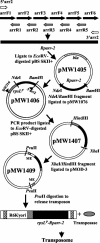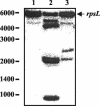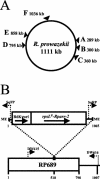Transposon mutagenesis of the obligate intracellular pathogen Rickettsia prowazekii
- PMID: 15128537
- PMCID: PMC404435
- DOI: 10.1128/AEM.70.5.2816-2822.2004
Transposon mutagenesis of the obligate intracellular pathogen Rickettsia prowazekii
Abstract
Genetic analysis of Rickettsia prowazekii has been hindered by the lack of selectable markers and efficient mechanisms for generating rickettsial gene knockouts. We have addressed these problems by adapting a gene that codes for rifampin resistance for expression in R. prowazekii and by incorporating this selection into a transposon mutagenesis system suitable for generating rickettsial gene knockouts. The arr-2 gene codes for an enzyme that ADP-ribosylates rifampin, thereby destroying its antibacterial activity. Based on the published sequence, this gene was synthesized by PCR with overlapping primers that contained rickettsial codon usage base changes. This R. prowazekii-adapted arr-2 gene (Rparr-2) was placed downstream of the strong rickettsial rpsL promoter (rpsL(P)), and the entire construct was inserted into the Epicentre EZ::TN transposome system. A purified transposon containing rpsL(P)-Rparr-2 was combined with transposase, and the resulting DNA-protein complex (transposome) was electroporated into competent rickettsiae. Following selection with rifampin, rickettsiae with transposon insertions in the genome were identified by PCR and Southern blotting and the insertion sites were determined by rescue cloning and inverse PCR. Multiple insertions into widely spaced areas of the R. prowazekii genome were identified. Three insertions were identified within gene coding sequences. Transposomes provide a mechanism for generating random insertional mutations in R. prowazekii, thereby identifying nonessential rickettsial genes.
Figures




Similar articles
-
Mariner-based transposon mutagenesis of Rickettsia prowazekii.Appl Environ Microbiol. 2007 Oct;73(20):6644-9. doi: 10.1128/AEM.01727-07. Epub 2007 Aug 24. Appl Environ Microbiol. 2007. PMID: 17720821 Free PMC article.
-
Transformation of Rickettsia prowazekii to rifampin resistance.J Bacteriol. 1998 Apr;180(8):2118-24. doi: 10.1128/JB.180.8.2118-2124.1998. J Bacteriol. 1998. PMID: 9555894 Free PMC article.
-
Transformation frequency of a mariner-based transposon in Rickettsia rickettsii.J Bacteriol. 2011 Sep;193(18):4993-5. doi: 10.1128/JB.05279-11. Epub 2011 Jul 15. J Bacteriol. 2011. PMID: 21764933 Free PMC article.
-
Progress in rickettsial genome analysis from pioneering of Rickettsia prowazekii to the recent Rickettsia typhi.Ann N Y Acad Sci. 2005 Dec;1063:13-25. doi: 10.1196/annals.1355.003. Ann N Y Acad Sci. 2005. PMID: 16481486 Review.
-
Dissecting the Rickettsia prowazekii genome: genetic and proteomic approaches.Ann N Y Acad Sci. 2005 Dec;1063:35-46. doi: 10.1196/annals.1355.005. Ann N Y Acad Sci. 2005. PMID: 16481488 Review.
Cited by
-
Establishment of a replicating plasmid in Rickettsia prowazekii.PLoS One. 2012;7(4):e34715. doi: 10.1371/journal.pone.0034715. Epub 2012 Apr 17. PLoS One. 2012. PMID: 22529927 Free PMC article.
-
Mutations in Ehrlichia chaffeensis Causing Polar Effects in Gene Expression and Differential Host Specificities.PLoS One. 2015 Jul 17;10(7):e0132657. doi: 10.1371/journal.pone.0132657. eCollection 2015. PLoS One. 2015. PMID: 26186429 Free PMC article.
-
Transposon insertion reveals pRM, a plasmid of Rickettsia monacensis.Appl Environ Microbiol. 2007 Aug;73(15):4984-95. doi: 10.1128/AEM.00988-07. Epub 2007 Jun 15. Appl Environ Microbiol. 2007. PMID: 17575002 Free PMC article.
-
Transcriptional pathways associated with the slow growth phenotype of transformed Anaplasma marginale.BMC Genomics. 2013 Apr 22;14:272. doi: 10.1186/1471-2164-14-272. BMC Genomics. 2013. PMID: 23607288 Free PMC article.
-
New criteria for selecting the origin of DNA replication in Wolbachia and closely related bacteria.BMC Genomics. 2007 Jun 20;8:182. doi: 10.1186/1471-2164-8-182. BMC Genomics. 2007. PMID: 17584494 Free PMC article.
References
-
- Alexeyev, M. F., and H. H. Winkler. 1999. Gene synthesis, bacterial expression and purification of the Rickettsia prowazekii ATP/ADP translocase. Biochim. Biophys. Acta 1419:299-306. - PubMed
-
- Andersson, S. G. E., A. Zomorodipour, J. O. Andersson, T. Sicheritz-Ponten, U. C. M. Alsmark, R. M. Podowski, A. K. Nslund, A. S. Eriksson, H. H. Winkler, and C. G. Kurland. 1998. The genome sequence of Rickettsia prowazekii and the origin of mitochondria. Nature 396:133-143. - PubMed
-
- Ausubel, F., R. Brent, R. E. Kingston, D. D. Moore, J. G. Seidman, J. A. Smith, and K. Struhl. 1997. Current protocols in molecular biology, vols. 1, 2, and 3. John Wiley & Sons, Inc., New York, N.Y.
-
- Bullock, W. O., J. M. Fernandez, and J. M. Short. 1987. A high efficiency plasmid transforming recA Escherichia coli strain with beta-galactosidase selection. BioTechniques 5:376-379.
Publication types
MeSH terms
Substances
Grants and funding
LinkOut - more resources
Full Text Sources

